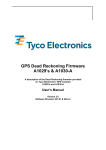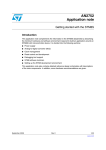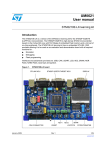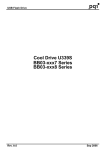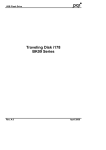Download GPS Receiver A1030-A
Transcript
GPS Receiver A1030-A A description of Tyco Electronics’ GPS module A1030-A User’s Manual Version 2.0 Hardware Revision 01 This page was intentionally left blank. Revision History Revision History Rev. Date 1.0 06-22-04 1.1 17-09-04 1.2 18-11-04 2.0 07-14-05 Description Initial Draft – Preliminary version Introduced corrections from R&D, extensions towards functionality, new mechanical dimensions, a few I/O changes Correct memory size, additional products, change in Dead Reckoning pin out (!), Detailed pin description, new orientation of layout (to match the orientation of A1029-B), introduction of Dead Reckoning interface, generally more detailed information mm-dd-yy V2.0 - 07/05 User’s Manual Page 3 of 37 Disclaimer Disclaimer THIS DOCUMENT CONTAINS PROPRIETARY INFORMATION OF TYCO ELECTRONICS CORPORATION/POWER SYSTEMS (TYCO ELECTRONICS). IT MAY NOT BE COPIED OR TRANSMITTED BY ANY MEANS, PASSED TO OTHERS, OR STORED IN ANY RETRIEVAL SYSTEM OR MEDIA, WITHOUT PRIOR CONSENT OF TYCO ELECTRONICS OR ITS AUTHORIZED AGENTS. THE INFORMATION IN THIS DOCUMENT IS, TO THE BEST OF OUR KNOWLEDGE, ENTIRELY CORRECT. HOWEVER, TYCO ELECTRONICS CAN NEITHER ACCEPT LIABILITY FOR ANY INACCURACIES, OR THE CONSEQUENCES THEREOF, NOR FOR ANY LIABILITY ARISING FROM THE USE OR APPLICATION OF ANY CIRCUIT, PRODUCT, OR EXAMPLE SHOWN IN THE DOCUMENT. THE PRODUCT (HARD- AND SOFTWARE) DESCRIBED IN THIS DOCUMENTATION IS NOT AUTHORIZED FOR USE IN LIFE SUPPORT DEVICES OR SYSTEMS WITHOUT THE EXPRESS WRITTEN APPROVAL OF TYCO ELECTRONICS. THIS DOCUMENT MAY PROVIDE LINKS TO OTHER WORLD WIDE WEB SITES OR RESOURCES. BECAUSE TYCO ELECTRONICS HAS NO CONTROL OVER SUCH SITES AND RESOURCES, TYCO ELECTRONICS SHALL NOT BE RESPONSIBLE FOR THE AVAILABILITY OF SUCH EXTERNAL SITES OR RESOURCES, AND DOES NOT ENDORSE AND IS NOT RESPONSIBLE OR LIABLE FOR ANY CONTENT, ADVERTISING, PRODUCTS, OR OTHER MATERIALS ON OR AVAILABLE FROM SUCH SITES OR RESOURCES. TYCO ELECTRONICS SHALL NOT BE RESPONSIBLE OR LIABLE, DIRECTLY OR INDIRECTLY, FOR ANY DAMAGE OR LOSS CAUSED OR ALLEGED TO BE CAUSED BY OR IN CONNECTION WITH USE OF OR RELIANCE ON ANY SUCH CONTENT, GOODS OR SERVICES AVAILABLE ON OR THROUGH ANY SUCH SITE OR RESOURCE. TYCO ELECTRONICS RESERVES THE RIGHT TO CHANGE, MODIFY, OR IMPROVE THIS DOCUMENT OR THE PRODUCT DESCRIBED HEREIN, AS SEEN FIT BY TYCO ELECTRONICS WITHOUT FURTHER NOTICE. Page 4 of 37 User’s Manual V2.0 - 07/05 Table of Contents Table of Contents 1 Introduction ........................................................................................................ 7 1.1 Dead Reckoning................................................................................................ 7 1.2 Label ................................................................................................................. 8 1.3 Characteristics .................................................................................................. 8 1.4 Handling Precautions ........................................................................................ 8 2 Ordering Information ......................................................................................... 9 2.1 GPS Receiver A1030-A .................................................................................... 9 2.2 Packing ............................................................................................................. 9 2.3 Additional Equipment ...................................................................................... 10 2.3.1 Demonstration and Evaluation Kits .............................................................. 10 2.3.2 Development and Target Platforms.............................................................. 10 3 Quick Start........................................................................................................ 11 3.1 Minimum Configuration ................................................................................... 11 3.2 Antenna Connection........................................................................................ 12 3.3 Serial Port Settings ......................................................................................... 12 3.4 Improved TTFF ............................................................................................... 12 4 Mechanical Outline .......................................................................................... 13 4.1 Mechanical Overview ...................................................................................... 13 4.2 Connector ....................................................................................................... 13 5 Pin Out Information.......................................................................................... 14 5.1 Standard GPS and DR Firmware Configuration.............................................. 14 5.1.1 Layout .......................................................................................................... 14 5.1.2 Description ................................................................................................... 15 5.2 General Comments ......................................................................................... 16 5.3 Free Configuration .......................................................................................... 16 6 Dead Reckoning Interface ............................................................................... 19 6.1 Odometer and Reverse Signals ...................................................................... 19 6.2 Gyro and Gyro Signal...................................................................................... 20 6.3 Power Supply for Internal ADC ....................................................................... 21 7 Memory Map ..................................................................................................... 22 8 Electrical Characteristics ................................................................................ 23 8.1 Operating Conditions ...................................................................................... 23 8.2 Absolute Maximum Ratings ............................................................................ 23 9 Mounting........................................................................................................... 24 10 Use of Antenna............................................................................................... 25 10.1 Active Antenna .............................................................................................. 25 10.2 Passive Antenna ........................................................................................... 25 11 Quality and Reliability.................................................................................... 26 V2.0 - 07/05 User’s Manual Page 5 of 37 Table of Contents 11.1 Environmental Conditions ............................................................................. 26 11.2 Product Qualification ..................................................................................... 26 11.3 Production Test ............................................................................................. 26 12 Applications and Hints .................................................................................. 27 12.1 Minimum Configuration ................................................................................. 27 12.2 Antenna Sensor Pin (ANTSTAT)................................................................... 27 12.3 Gain select pin (GS)...................................................................................... 27 12.4 VANT pin (antenna voltage input pin) ........................................................... 27 12.5 LOCK pin (position fix pin) ............................................................................ 28 12.6 ENABLE pin (low-power mode)..................................................................... 28 12.7 1PPS pin (1 pulse per second pin)................................................................ 28 12.8 Reset Signal.................................................................................................. 29 12.9 VBAT pin....................................................................................................... 30 12.10 Usage of additional interfaces ..................................................................... 30 12.10.1 I2C ........................................................................................................... 30 12.10.2 BSPI......................................................................................................... 30 12.10.3 HDLC ....................................................................................................... 31 12.10.4 CAN ......................................................................................................... 31 12.10.5 USB Slave Interface................................................................................. 31 13 Application Software ..................................................................................... 33 14 Demonstration and Evaluation Kit................................................................ 34 15 Related Information ....................................................................................... 35 15.1 Contact.......................................................................................................... 35 15.2 Related Documents....................................................................................... 35 16 List of Tables .................................................................................................. 37 17 List of Figures ................................................................................................ 37 Page 6 of 37 User’s Manual V2.0 - 07/05 GPS Receiver A1030-A 1 Introduction Tyco Electronics’ GPS module A1030-A is a highly integrated GPS receiver module. It is capable of receiving signals from up to 12 GPS satellites and transferring them into position and timing information that can be read over a serial port. The A1030 extends Tyco Electronics’ GPS receiver family based on the ST Microelectronics’ STA2051, already represented by the A1029-A and A1029-B. In addition to these receivers, it offers additional Flash, SRAM and I/O and is therefore ideally suited for customer applications. The A1030 basic firmware features high-end GPS functionality at low power consumption. Major highlights of the module are: • • • • • • • • • • 4Mbit Flash and 2Mbit SRAM Operable at 3.3V / 50mA @ 1fix per second Antenna link cable with SMA connector Antenna sensor pin with defined current sensing range (for antenna detection or antenna short circuit detection) LNA Gain select pin (for adjustment to various RF signal conditions) Current limiter (50mA) for active antennas Hardware and software stand-by @ 500µA Wait-for-IRQ @ 1mA Battery back-up mode (RTC and SRAM supported) Access to SPI, I2C, HDLC, CAN, USB, Smart Card interface with customer software This GPS receiver is available as an off-the-shelf component, 100% tested and shipped in trays. 1.1 Dead Reckoning The A1030 offers Dead Reckoning capability. The I/O connector allows connecting to the necessary signals. This manual holds a detailed description on setting up a Dead Reckoning solution. V2.0 - 07/05 User’s Manual Page 7 of 37 GPS Receiver A1030-A 1.2 Label The A1030’s labels hold the following information: Product code (A1030-A) with hardware version (01) A1030-A-01 Firmware version (102-01), factory and date code (week and year: 3105) 102-01 BZ/31/05 Figure 1: A1030 labels 1.3 Characteristics The modules are characterized by the following parameters. Channels Frequency Position Accuracy Time To First Fix – TTFF (theoretical minimum values; values in real world may differ) Mechanical dimensions Stand alone Differential Obscuration recovery (1) Hot start (2) Warm (3) Autonomous / cold (4) (6) Power-off start (5) (6) Length Width Height Weight 12, parallel tracking L1 (= 1575 MHz) 3m CEP (SA off) < 2m CEP 1s < 3s < 32s < 60s Varying 39.37mm, 1.55” 35.56mm, 1.4” 6.7mm, 0.26” 11g, 0.4oz Table 1: A1030-A characteristics (1) (2) (3) (4) (5) The calibrated clock of the receiver has not stopped, thus it knows precise time (to the µs level). The receiver has estimates of time/date/position and valid almanac and ephemeris data. The receiver has estimates of time/date/position and recent almanac. The receiver has no estimate of time/date/position, and no recent almanac. Receiver is powered off, clock stops. Start-up time depends on time passed since power-off and power-on location. (6) In order to improve TTFF, the receiver allows setting of time/date/position. 1.4 Handling Precautions The GPS receiver A1030-A is a module that is sensitive to electrostatic discharge (ESD). Please handle with appropriate care. Page 8 of 37 User’s Manual V2.0 - 07/05 GPS Receiver A1030-A 2 Ordering Information 2.1 GPS Receiver A1030-A The order numbers are built as follows: • V23993A1030Axxx V23993 stands for Tyco Electronics wireless and communication products, A1030A for the A1030-A module. The “xxx” stands for the according firmware version. Where • • “1xx” is standard GPS software “2xx” is GPS software with Dead Reckoning support The functionality of both software versions is reflected in the according manuals. 2.2 Packing The A1030-A comes in trays, with 12 modules per tray. All dimensions in [mm] Figure 2: A1030-A tray specifications V2.0 - 07/05 User’s Manual Page 9 of 37 GPS Receiver A1030-A 2.3 Additional Equipment 2.3.1 Demonstration and Evaluation Kits V23993-DKS1030-A V23993-DKS1030-B V23993-DR1030-A Demonstration and evaluation board (including one module V23993-A1030-A) without LCD Demonstration and evaluation board (including one module V23993-A1030-A) with LCD Dead Reckoning demonstration and evaluation system for testing in vehicles; integrated gyro; external signals (odometer pulse, forward/reverse) required. Table 2: Demonstration and evaluation kits 2.3.2 Development and Target Platforms V23993-DEV1030-A V23993-DEV1030-B V23993-DTK1030-A Development platform incl. Rowley Toolset, hardware interface adapter, demonstration and evaluation board without LCD, libraries, sample code, description. Development platform incl. Rowley Toolset, hardware interface adapter, demonstration and evaluation board with LCD, libraries, sample code, description. Development platform incl. Rowley Toolset, hardware interface adapter, libraries, sample code, description. Table 3: Development platforms Detailed descriptions of the additional kits can be found in the according manuals. Page 10 of 37 User’s Manual V2.0 - 07/05 GPS Receiver A1030-A 3 Quick Start In order to allow an easy and quick start with the GPS module A1030-A, this chapter provides a short overview on the most important steps to receive NMEA messages with position information on a serial port. For details please refer to the according chapters. 3.1 Minimum Configuration The following picture shows a recommended minimum configuration for NMEA output and commands received and sent via an RS232 interface. Figure 3: Recommended minimum configuration Remarks: • • Place C1 to C5 close to MAX3232. For capacity values see datasheet of actual component used. Use 3.3V level shifter (MAX323 or equivalent). V2.0 - 07/05 User’s Manual Page 11 of 37 GPS Receiver A1030-A 3.2 Antenna Connection It is recommended to use an active GPS antenna with supply voltage of 3 to 5VDC and a current draw of 50mA maximum. The on-module current limiter will not allow use of antennas with a higher current draw. In addition, it is recommended to use an antenna with a current draw that falls into the range detectable by the internal antenna current monitor. The values are defined in paragraph 12.2 Antenna Sensor Pin (ANTSTAT). The quality of the GPS antenna chosen is of paramount importance for the overall sensitivity of the GPS system. An active antenna should have a gain ≥ 20dB and a noise figure ≤ 1.5dB, which applies to more than 95% of the antennas available in the market. 3.3 Serial Port Settings The default configuration within the standard GPS firmware is: • • Serial 0 (NMEA) 4800 baud, 8 data bits, no parity, 1 stop bit, no flow control Serial 2 (RTCM) 4800 baud, 8 data bits, no parity, 1 stop bit, no flow control The default configuration within the Dead Reckoning GPS firmware is: • • Serial 0 (NMEA) 57600 baud, 8 data bits, no parity, 1 stop bit, no flow control Serial 2 (RTCM) 4800 baud, 8 data bits, no parity, 1 stop bit, no flow control 3.4 Improved TTFF In order to improve the TTFF (Time To First Fix), it is recommended to support the module – and therefore the RTC - with a back-up battery when no system power is available. Standard operation mode is entered with the ENABLE pin on HIGH level. With the Wakeup ENABLE pin on LOW level, low power mode will be entered. If still power is being supplied to VBAT, the RTC keeps on running while the internal processors will be stopped. The power consumption will drop from typically 50mA to typically 30µA. Please see also paragraph 12.6 ENABLE pin (low-power mode). Page 12 of 37 User’s Manual V2.0 - 07/05 GPS Receiver A1030-A 4 Mechanical Outline 4.1 Mechanical Overview All dimensions in [mm] Figure 4: Mechanical outline (bottom view) 4.2 Connector The power and I/O connector used on the A1030-A is a 1.27mm (0.05”) low profile, double row socket with a height of 2.21mm (.087”) and a total of 50 contacts. Potential counterparts on the motherboard are e.g. Harwin 1.27mm (0.05”) micro strips of the M50 series. V2.0 - 07/05 User’s Manual Page 13 of 37 GPS Receiver A1030-A 5 Pin Out Information The functionality of the pins can be configured by software. This chapter describes the pin out configuration with Tyco standard GPS firmware including the pin out for a Dead Reckoning configuration and possible configurations with different interfaces. 5.1 Standard GPS and DR Firmware Configuration 5.1.1 Layout Figure 5: Pin out information (bottom and top view) Bottom view is showing the side of the module that will face the carrier board. Page 14 of 37 User’s Manual V2.0 - 07/05 GPS Receiver A1030-A 5.1.2 Description This table describes the functionality of the pins with Tyco Standard GPS firmware or Dead Reckoning firmware running on the module. The associated symbols are explained. General-purpose pins that are not supported in the standard firmware are explained further down below. Pin 1 3 5 7 9 11 13 19 21 23 29 33 37 39 41 45 47 49 Symbol GND Vcc VBAT ENABLE nRST Rx0 Tx0 Rx2 Tx2 TEST0 Vgyro LOCK GS ANTSTAT VANT Vcc3A Odo F/R Description Ground (power supply) +3.3V (power supply) Back-up battery supply pin (RTC and SRAM) Enable pin – low power when low Reset input Serial input 0, NMEA in Serial output 0, NMEA out Serial input 2, RTCM input (DGPS) Serial output 2 Reserved for test purposes Input pin for gyro output voltage (required for DR) Activated on LOCK (position fix) Gain Select for LNA – leave open Antenna sensor output Power supply Antenna external Analog voltage supply < +3.3V (required for DR) Odometer input (required for DR) Reverse signal input (required for DR) Table 4: Pin out description (odd signal numbers) Pin 2 10 46 48 50 Symbol Res. 1PPS Res. Res. Res. Description Reserved for future use – do not connect 1PPS (pulse per second) output Reserved for future use – do not connect Reserved for future use – do not connect Reserved for future use – do not connect Table 5: Pin out description (even signal numbers) V2.0 - 07/05 User’s Manual Page 15 of 37 GPS Receiver A1030-A 5.2 General Comments The following comments should be considered for a design with and use of the module: • • • • Standard configuration of serial port (no DR software): Serial 0 (NMEA) 4800 baud, 8 data bits, no parity, 1 stop bit, no flow control Serial 2 (DGPS) 4800 baud, 8 data bits, no parity, 1 stop bit, no flow control Standard configuration of serial port (with DR software): Serial 0 (NMEA) 57600 baud, 8 data bits, no parity, 1 stop bit, no flow control Serial 2 (DGPS) 4800 baud, 8 data bits, no parity, 1 stop bit, no flow control Gain Select Default setting is “open” (identical to logical low), which results in a high gain (14dB). This setting is recommended. nRST Do not pull low when in low power mode 5.3 Free Configuration For custom specific applications, all pins are more or less user definable. The final function of a pin is determined by software running in the STA2051 (Vespucci). Please refer also to chapter “12.10 Usage of additional interfaces” and for detailed information to the STMicroelectronic STA2051 Vespucci User Manual. The following tables describe the pin numbers “Pin”, the function of the pin as a specific function of the A1030-A or as configured in the standard or Dead Reckoning firmware “Function”, the according pin on the STA2051 (Vespucci) “STA2051”, the direction of the signal “Dir.”, and the description of the according functionality ”Description”. Page 16 of 37 User’s Manual V2.0 - 07/05 GPS Receiver A1030-A Pin Function STA2051 1 3 5 7 9 GND Vcc33 VBAT ENABLE nRST nRSTIN 11 Rx0 P0.8 13 Tx0 P0.9 I V33 P0.10 17 P0.11 19 Rx2 P0.13 21 Tx2 P0.14 23 TEST0 BOOTEN 25 P1.4 27 P1.5 29 P1.0 31 P1.1 33 P1.2 35 P1.3 GS ANTSTAT VANT 43 I Digital Supply Voltage for I/O circuitry (3.3 Volt) I A1030 specific: Battery back-up pin for RTC and SRAM I 15 37 39 41 Dir. Description I I/O I O I/O I O I/O I O I/O I O I/O I O I/O I O I I/O I I I/O I O I/O O AI I/O I AI I/O O AI I/O I AI I O P0.12 45 Vcc3A VDD 47 Odo P0.6 49 F/R P0.7 I I/O O I I/O I/O I/O I Reset Input with Schmitt-Trigger characteristics and noise filter. General Purpose I/O U0.RX: UART 0 - Receive Data Input U0.TX: UART 0 - Transmit Data Output General Purpose I/O BOOT.0 - Special BOOT configuration select U0.TX: UART 0 - Transmit Data Output General Purpose I/O U1.RX: UART 1 - Receive Data Input U1.TX: UART 1 - Transmit Data Output General Purpose I/O BOOT.1 - Special BOOT configuration select U1.TX: UART 1 - Transmit Data Output General Purpose I/O U2.RX: UART 2 - Receive Data Input T2.OCMPA: Extended Function Timer 2 - Output Compare A General Purpose I/O T2.ICAPA: Extended Function Timer 2 - Input Capture A U2.TX: UART 2 - Transmit Data Output Enables sampling of BOOT[1:0] pins on exit from external Reset General Purpose I/O T1.ICAPA: Ext. Funct. Timer 1 - Input Capture A or External Clock HTXACT: HDLC - Transmit Buffer Active General Purpose I/O T1.ICAPB: Extended Function Timer 1 - Input Capture B HOVSCLK: HDLC - oversampling Clock Out General Purpose I/O T3.OCMPB: Extended Function Timer 3 - Output Compare B AIN0: ADC - Analog Data Input 0 General Purpose I/O T3.ICAPA: Ext. Funct. Timer 3 - Input Capture A or External Clock AIN1: ADC - Analog Data Input 1 General Purpose I/O T3.OCMPA: Ext. Function Timer 3 - Output Compare A or PWM AIN2: ADC - Analog Data Input 2 General Purpose I/O T3.ICAPB: Extended Function Timer 3 - Input Capture B AIN3: ADC - Analog Data Input 3 Gain select (open = default = high gain) Antenna status Antenna voltage supply General Purpose I/O SCCLK: Smart Card - Reference Clock Output Analog Supply Voltage for the A/D Converter General Purpose I/O S0.SCLK: BSPI 1 - Serial Clock General Purpose I/O S1.SSN: BSPI 1 - Slave Select Table 6: A1030 odd pins V2.0 - 07/05 User’s Manual Page 17 of 37 GPS Receiver A1030-A Pin Function 2 Res. STA2051 P0(2) 4 P0(3) 6 P1(6) 8 P1(7) 10 1PPS P1(8) 12 P1(9) 14 P1(10) 16 P1(11) 18 P1(12) 20 P1(13) 22 P1(14) 24 P1(15) 26 P2(8) 28 P2(9) 30 P2(10) 32 P2(11) 34 36 38 40 42 44 P2(12) P2(13) P2(14) P2(15) USBDP USBDN 46 Res. P0(4) 48 Res. P0(0) 50 Res. P0(1) Dir. Description I/O I/O I/O I/O I/O O I/O O I/O O I/O O I/O O I/O I I/O I I/O O I/O I/O I I/O I/O I I/O O I/O I I/O I I/O I I/O I I/O General Purpose I/O S0.SCLK: BSPI 0 - Serial Clock I1.SCL: I2C - Serial Clock General Purpose I/O I1.SDA: I2C - Serial Data S0.SSN: BSPI 0 - Slave Select General Purpose I/O T1.OCMPB: Extended Function Timer 1- Output Compare B General Purpose I/O T1.OCMPA: Ext. Function Timer 1- Output Compare A or PWM General Purpose I/O PPS: GPS Pulse Per Second General Purpose I/O PRN: GPS Pseudo-Random Sequence generator (PRN11) General Purpose I/O USBCLK – 48Mhz clock for USB interface General Purpose I/O CANRX: CAN – Receive Data Input General Purpose I/O CANTX: CAN - Transmit Data Output General Purpose I/O I0.SCL: I2C – Serial Clock HCLK – HDLC reference clock General Purpose I/O I1.SDA: I2C - Serial Data HRXD - HDLC - Receive Data Input General Purpose I/O HTXD – HDLC – Transmit Data Output General Purpose I/O INT2: External Interrupt - Input Channel 2 General Purpose I/O INT3: External Interrupt – Input Channel 3 General Purpose I/O INT4: External Interrupt - Input Channel 4 General Purpose I/O INT5: External Interrupt – Input Channel 5 General Purpose I/O I/O General Purpose I/O I/O General Purpose I/O I/O General Purpose I/O I/O USB Serial line – Positive I/O I/O I/O I/O I/O O I/O I/O O USB Serial line – Negative General Purpose I/O S1.MISO: BSPI 1 - Master Input / Slave Output General Purpose I/O S0.MISO: BSPI 0 – Master Input / Slave Output U3.TX: UART 3 – Transmit Data Output General Purpose I/O S0.MOSI: BSPI 0 - Master Output / Slave Input U3.RX: UART 3 - Receive Data Input Table 7: A1030 even pins Page 18 of 37 User’s Manual V2.0 - 07/05 GPS Receiver A1030-A 6 Dead Reckoning Interface Dead Reckoning (DR) functionality requires the correct firmware (“2xx”) and the correct hardware set-up on the main board. Two digital signals (odometer and reverse), a gyro and according power supply for the internal ADC are necessary to support this feature. This chapter shall provide all necessary information for designing an according main board. The recommendations here assume the availability of a 5V (VCC5D) and 3.3V (VCC3D) digital power supply on this main board. 6.1 Odometer and Reverse Signals Both signals are provided by the vehicle. In order to connect the signals in the correct way to the module, they should be optically isolated. The following schematic is an example on how an implementation could look like. Figure 6: Connecting an odometer signal The same configuration can be used for the reverse signal. V2.0 - 07/05 User’s Manual Page 19 of 37 GPS Receiver A1030-A 6.2 Gyro and Gyro Signal The gyro is of utmost importance for the performance of the DR system. The following data shall provide a guideline for selecting the right gyro: Basic gyro data • Supply voltage: 5V (more gyros available, also used in the example) or 3V • Current draw: < 20mA • Max. angular velocity: ± 80 deg / s • Output at angular velocity 0: 1.5V (or 2.5V and according divider, as shown in the example) • Resolution: ~ 0.1 deg / s • Scale factor: ~ 25mV / deg / s (smaller values possible, e.g. 12.5mV / deg / s at supply voltage 3V) Important for system performance as well: • Temperature coefficient of scale factor: max. ± 10% at -30° to +80°C • Linearity: ± 0.5% full scale • Offset drift: e.g. for ENV-05G Murata: 9 deg / s (smaller values desirable) • Response: max. 10Hz • Noise level; max. 10mVp-p In the example (also the DR1030A board), the Murata ENV-05G is used, a 5V gyro with an output of 2.5V at 0°/s angular velocity. To allow the complete output range to fit into the input range of the internal ADC, a 2:1 divider is used. Figure 7: Connecting a gyro and the gyro signal Page 20 of 37 User’s Manual V2.0 - 07/05 GPS Receiver A1030-A 6.3 Power Supply for Internal ADC The internal ADC requires a separate power supply on pin Vcc3A. The power should be derived from the same source that is used for the gyro. This way, oscillations of the power source affect the gyro and the ADC and therefore minimize the negative effects. It is also recommended that Vcc3A is slightly below the power supplied to module (Vcc). The following circuit shows an example on how to generate the power for the internal ADC from a 5V source. Figure 8: Power supply for internal ADC (Vcc3A) V2.0 - 07/05 User’s Manual Page 21 of 37 GPS Receiver A1030-A 7 Memory Map Beside the internal register, RAM and Flash access, the module offers – depending on its version) additional external Flash and / or SRAM. The external memory is addressed via a 16bit interface at the following addresses: Memory type Address Flash SRAM 0x60000000 0x62000000 Table 8: External memory map A theoretical total of a memory space of 224 bytes (corresponding to 16 Mbytes or 128 Mbit) of SRAM and Flash respectively can be addressed. Not existing memory is simply mirrored. For example the Flash memory of a module equipped with 8Mbit will be seen at address 0x60000000, 0x60100000, 0x60200000, and so on. For information on the internal memory map, please refer to STMicroelectronics Vespucci User Manual. Page 22 of 37 User’s Manual V2.0 - 07/05 GPS Receiver A1030-A 8 Electrical Characteristics 8.1 Operating Conditions Pin Description Min Typical Max 3 Vcc Current draw (without active Antenna) Input current in standby mode 1 PPS (1 pulse per second), reference GPS time (active and passive antenna) VANT (active antenna supply voltage) Antenna current GS (gain select for LNA), input pin GS high (Low gain – 4dB) GS low (high gain – 14dB) ANTSTAT (antenna sensor output) @ 1mA current source High at antenna current from 9 to 16mA Low at antenna current <9mA or >16mA Output pins VOH VOL Input pins VIH VIL 3.0V 3.3V 50mA 30µA +120ns +90ns 3.6V 10 41 37 39 Vcc-0.5V 5.2V 50mA Vcc-0.6V Vcc 0.6V Vcc-0.5V 0 Vcc 0.5V Vcc-0.8V 0.4V 0.7Vcc 0.3Vcc Table 9: Operating Conditions 8.2 Absolute Maximum Ratings Pin 3 Description Vcc Current Antenna, external power supply Applied voltage to all input pins excluding Vcc, VANT Min -0.3V -0.3V Max 3.6V 50mA Vcc+0.3V max. 3.6V Table 10: Absolute maximum ratings Stresses beyond those listed under “Absolute Maximum Ratings” may cause permanent damage to the device. This is a stress rating only. Functional operation of the device at these or any other conditions beyond those indicated in the operational sections of this specification is not implied. Exposure to absolute maximum rating conditions for extended periods may affect device reliability. V2.0 - 07/05 User’s Manual Page 23 of 37 GPS Receiver A1030-A 9 Mounting This chapter covers the mounting of the A1030-A. The A1030-A offers a power and I/O connector with a 1.27mm (0.05”) low profile, double row socket with a total of 50 contacts. Potential counterparts on the motherboard are Harwin 1.27mm (0.05”) micro strips of the M50 series. For fixing the A1030-A on a motherboard appropriate screws and bolts or clips (see also chapter 4.1 Mechanical Overview ff.) are recommended. Page 24 of 37 User’s Manual V2.0 - 07/05 GPS Receiver A1030-A 10 Use of Antenna 10.1 Active Antenna General GPS active antenna specification: Limitations: • • Supply voltage according to voltage fed into VANT pin (5V max.) Supply current 50mA (max.) Recommendations: • • Gain ≥ 20dB Noise figure ≤ 1.5dB The recommendations apply to the majority of active antennas that can be found in the market. Anyhow, the quality of the GPS antenna chosen is of paramount importance for the overall sensitivity of the GPS system. The system design needs to reflect the supply voltage of the antenna. If the supply voltage is equal to Vcc, Vcc can be connected to VANT. If the antenna requires a different supply voltage, the antenna bias can be provided through the VANT pin. 10.2 Passive Antenna NOTE: Different passive antenna set-ups have been tested with positive results on the performance of the A1030-A module. Anyhow, it is the responsibility of the system integrator to qualify the final configuration. Please consider that it is crucial to keep the connection from the antenna to the ANT pin as short as possible. Each bit of attenuation between the passive antenna and the ANT pin will degrade GPS performance. Recommendations: • • Antenna gain: >2dBi Antenna gain: < 2dBi / LNA close to the antenna recommended! Please make sure that the antenna is properly tuned to its dielectric environment. V2.0 - 07/05 User’s Manual Page 25 of 37 GPS Receiver A1030-A 11 Quality and Reliability 11.1 Environmental Conditions Operating temperature Operating humidity MSL JEDEC (Moisture Sensitivity Level) Storage - 40 … + 85°C Max. 85% r. H., non-condensing, at 85°C 3 6 months in original package. Table 11: Environmental conditions 11.2 Product Qualification Prior to product qualification the GPS receiver is preconditioned according to EIA/JEDEC standard JESD22-A113-B / Level 3. Basic qualification tests: • • • • • • Temperature Cycling -40 … +85°C Temperature Humidity Bias 85°C / 85% RH High / Low Temperature Operating –40° / +85°C High Temperature Operating Life +85°C Vibration Variable Frequency Mechanical Shock Please contact Tyco Electronics for detailed information. 11.3 Production Test Each module is electrically tested prior to packing and shipping to ensure state of the art GPS receiver performance and accuracy. Page 26 of 37 User’s Manual V2.0 - 07/05 GPS Receiver A1030-A 12 Applications and Hints 12.1 Minimum Configuration Please refer to chapter 3.1 Introduction for details. In addition, for optimized start-up behavior it is strongly recommended to provide power at the VBAT pin when pulling the ENABLE pin to LOW. This will improve start-up times after wake-up! 12.2 Antenna Sensor Pin (ANTSTAT) The Antenna Sensor pin is an output pin. It provides correct status information for an active GPS antenna with current consumption in the defined range! For an active antenna with a current consumption outside this range, an external circuit could detect the connection or a disconnection or a short circuit. • • • Logic low when: Logic high when: Logic low when: Iant < 9mA 9mA > Iant < 16mA Iant > 16mA Iant = DC current of GPS antenna (DC current through sensing resistor on GPS module) The Antenna Sensor pin can detect when an active antenna is connected. It can also detect when the antenna is short-circuited or disconnected for some reason. Please consider that the Antenna Sensor can provide no useful output when the GPS antenna is fed externally, i.e. the VANT pin is not used (the sensing resistor on the GPS module can not sense any DC current). 12.3 Gain select pin (GS) The LNA Gain Select pin is an input pin. • • Pin at GND (low) or open: LNA Gain 14dB (default) Pin at Vcc (high): LNA Gain 4dB It is recommended to leave the pin unconnected. This allows for amplification of weaker signals and a firmware implementation of an automatic gain control (AGC) function. 12.4 VANT pin (antenna voltage input pin) The VANT pin is an input pin. The supply voltage for an active GPS antenna has to be fed into the VANT pin. The easiest way to do that is to connect Vcc to VANT. The maximum current is 50mA. A current limiter is integrated on the module. V2.0 - 07/05 User’s Manual Page 27 of 37 GPS Receiver A1030-A 12.5 LOCK pin (position fix pin) The LOCK pin is an output pin. When there is no valid position fix, the signal on the pin will be a continuous logic low. During a valid position fix phase, the output signal will be a continuous logic high. This function is provided with the standard firmware only. 12.6 ENABLE pin (low-power mode) The ENABLE pin is an input pin. For enabling normal operation of the module, the pin has to be on HIGH level (e.g. connected to Vcc). When the ENABLE pin is pulled down to GND, the module will go to a low power mode where only the RTC will be supported (if a power source is still connected to VBAT). I.e. date and time will be valid after wake-up. The current draw will fall from typically 50mA to typically 30µA. Do not pull down low nRST at the same time! This is not necessary and will result in additional current draw! 12.7 1PPS pin (1 pulse per second pin) The 1PPS pin is an output pin. In addition to precise positioning, GPS also allows for accurate timing due to the synchronized atomic clocks in the GPS satellites. While the current date and time is transmitted in NMEA sentences, an exact and accurate timing signal is provided via the 1PPS pin of the A1030A module. The 1PPS signal is valid only, whenever the GPS modules provide a valid position fix. Therefore it is recommended to monitor the LOCK signal in parallel (or logically AND the 1PPS and LOCK signals). The rising edge of the signal is synchronized to GPS time and therefore also to UTC. The 1PPS signal is characterized (a) by the delay “d” between the start of a GPS second and the rising edge of the 1PPS and (b) by standard deviation of this delay providing a measure for the stability or jitter of this signal. Additionally, the duration “l” of the signal is outlined. Page 28 of 37 User’s Manual V2.0 - 07/05 GPS Receiver A1030-A Figure 9: 1PPS signal description Signal delay d (typical) Standard deviation σd (typical) Signal duration l (typical) 130ns 20ns 500ms Table 12: 1PPS signal characterization with active antenna with filter at 22°C Signal delay d (typical) Standard deviation σd (typical) Signal duration l (typical) 90ns 20ns 500ms Table 13: 1PPS signal characterization with passive antenna at 22°C The standard deviation is a probability measure for the occurrence of value within a certain range. 68.3% of all new values will be within 1σ of the expected value, 95.5% within 2σ. 12.8 Reset Signal The nRST pin is an input pin. The nRST pin can be used to generate a reset on the A1029 modules. Resetting the module will result in a restart of the complete firmware including the boot loader. All information stored in flash memory will still be valid. The RTC will keep on running. The same result can be achieved using the ENABLE pin. Therefore connecting nRST is not necessary. In case of low power mode (ENABLE pin low) DO NOT pull nRST to low. This will result in additional current draw. V2.0 - 07/05 User’s Manual Page 29 of 37 GPS Receiver A1030-A 12.9 VBAT pin The VBAT pin is an input pin. The module will draw current from the VBAT pin whenever Vcc will be LOW. The module will fall to stand-by mode and the RTC will keep on running. At the same time, the external (only!) is backed. 12.10 Usage of additional interfaces Additional interfaces can be used when writing specific software for the A1030. The most commonly used interfaces for the module are I2C, BSPI, HDLC, CAN and USB. Not all interfaces can be used simultaneously. Two I2C Interfaces are available. One of them is multiplexed with one BSPI interface, while the other is multiplexed with the HDLC; hence either one I2C + two BSPI, or two I2C + one BSPI, or one I2C, one BSPI and the HDLC, or two BSPI and the HDLC are available at any time. CAN and USB interfaces are independent of the other interfaces. For more details please refer to according chapters in the STMicroelectronic Vespucci User Manual. 12.10.1 I2C The I2C Bus Interface serves as an interface between the microcontroller and the external serial I2C bus. It provides both multi-master and slave functions, and controls all I2C bus-specific sequencing, protocol, arbitration and timing. It supports fast I2C mode (400kHz). A1030A: I2C interface one is realized via pin 02 (P0.2 – Serial Clock) and pin 04 (P0.3 - Serial Data), while interface two is realized via pin 20 (P1.13 – Serial Clock) and pin 22 (P1.14 - Serial Data). 12.10.2 BSPI The BSPI block is a standard 4-pin Serial Peripheral Interface for inter-IC control communication. It interfaces on one side to the SPI bus and on the other has a standard register data and interrupt interface. The BSPI contains two 10-word x 16-bit FIFO’s one for receive and the other for transmit. The BSPI can directly operate with words 8 and 16 bit long and generates vectored interrupts separately for receive and transmit events. A1030A: On the A1030, only one BSPI interface is completely available: 48: P0.0 - MISO 50: P0.1 - MOSI 02: P0.2 - SCLK 04: P0.3 - SSN Page 30 of 37 User’s Manual V2.0 - 07/05 GPS Receiver A1030-A 12.10.3 HDLC The HDLC interface supports both the Telepass protocol and the European TC278 DSRC communication standard. It supports Full Duplex operating mode with independent baudrates for transmit/receive, including PLL for clock recovery. It features NRZ, NRZI, Manchester encoding, automatic bit stuffing, FCS generation and CRC check. Packets are stored in a local dual-port memory, for later retrieval by the CPU; this buffer is sized to hold a full HDLC frame, to minimize CPU load during the transaction. A1030A: The HDLC interface pins are realized in the following way: 25: P1.4 - Transmit Buffer Active 27: P1.5 - Oversampling Clock Out 20: P1.13 - Reference Clock 22: P1.14 - Receiver Data Input 24: P1.15 - Transmit Data Output 12.10.4 CAN The C-CAN consists of the components CAN Core, Message RAM, Message Handler, Control Registers, and Module Interface. The CAN Core performs communication according to the CAN protocol version 2.0 part A and B. The bit rate can be programmed to values up to 1MBit/s. For the connection to the physical layer additional transceiver hardware is required. For communication on a CAN network, individual Message Objects are configured. The Message Objects and Identifier Masks for acceptance filtering of received messages are stored in the Message RAM. All functions concerning the handling of messages are implemented in the Message Handler. Those functions are the acceptance filtering, the transfer of messages between the CAN Core and the Message RAM, and the handling of transmission requests as well as the generation of the module interrupt. The register set of the CCAN can be accessed directly by the CPU via the module interface. These registers are used to control/configure the CAN Core and the Message Handler and to access the Message RAM. A1030A: The CAN signals CAN-TX and CAN-RX are realized on pins 18 and 16, respectively. 12.10.5 USB Slave Interface The USB_IP Peripheral provides an USB compliant connection between the host PC and the function implemented inside the ARM device. Data transfers between host PC and system memory occur through a dedicated packet buffer memory accessed directly by the USB_IP peripheral. This dedicated buffer memory must be sized according to the number of used endpoints and their related maximum packet sizes. In this implementation the dedicated memory is sized to 512 Byte and up to 8 V2.0 - 07/05 User’s Manual Page 31 of 37 GPS Receiver A1030-A endpoints can be used. The USB_IP interfaces with the USB host and detects token packets, handles data transmission/reception, and processes handshake packets as required by the USB standard. Transaction formatting is performed by hardware, including CRC generation and checking. Each endpoint is associated with a buffer description block indicating where the endpoint related memory area is located, how large it is or how many bytes must be transmitted. When a token for a valid function/endpoint pair is recognized by the USB_IP, the related data transfer (if required and if the endpoint is configured) takes place, with the USB_IP buffering data loaded in an internal 16 bit long register, and performing memory access to the dedicated buffer. When all data have been transferred, if needed, the proper handshake packet over the USB is generated or expected, according to the direction of the transfer. At the end of the transaction, an endpoint specific interrupt is generated: reading status registers and/or using different interrupt response routines, the microcontroller can determine which endpoint has to be served, which type of transaction took place, if errors occurred (bit stuffing, format, CRC, protocol, missing ACK, over/underrun, etc....). Special support is offered to isochronous transfers and high throughput bulk transfers, implementing a double buffer usage which allows having always an available buffer for the USB_IP while the microcontroller uses the other one. The unit can be placed in low-power mode (SUSPEND mode), by writing in a control register whenever required. At this time, all static power dissipation is avoided, and the macrocell clock can be slowed down or stopped. The detection of activity at the USB inputs while in low-power mode wakes the device up asynchronously. A special interrupt source can be connected directly to a wake-up line so as to allow the system to immediately restart normal clock generation and/or support direct clock start/stop. A1030A: USBDN is available on pin 44 and USBDP on pin 42. The 48MHz USB clock has to be provided on pin 14 (P1.10). Page 32 of 37 User’s Manual V2.0 - 07/05 GPS Receiver A1030-A 13 Application Software Tyco Electronics provides Standard GPS Software that covers the following basic functions of a GPS module: - Standard GPS functionality Dead Reckoning capability WAAS/EGNOS support Data logging For details, please refer to the GPS Firmware manuals. V2.0 - 07/05 User’s Manual Page 33 of 37 GPS Receiver A1030-A 14 Demonstration and Evaluation Kit For demonstration and easy evaluation of GPS performance Tyco Electronics offers a Demonstration and Evaluation Kit (including one GPS A1030-A module). It shows two serial interfaces (NMEA and RTCM). The kit can be powered by an external 5 to 12V source. Accompanied by an antenna and serial cable it offers a ready-to-go set. This platform is also feasible as a target for custom specific developments. With its standard JTAG interface, programming toolsets by ARM (RealView) or Rowley (CrossWorks for ARM) can be used. It offers access to all I/O pins. In addition, a Dead Reckoning test platform in a closed housing is available. This kit allows a wide power input range (7V to 32V) and avoids problems in an electrically dirty environment and makes the unit ideal for testing in vehicles. For further information please contact Tyco Electronics. Page 34 of 37 User’s Manual V2.0 - 07/05 GPS Receiver A1030-A 15 Related Information 15.1 Contact This manual was created with due diligence. We hope that it will be helpful to the user to get the most out of the GPS module. Anyway, inputs about errors or mistakable verbalizations and comments or proposals to TYCO Electronics, Power Systems in Munich, Germany, for further improvements are highly appreciated. Hans Wiedemann Product Marketing Manager Positioning Products Tel.: +49 89 6089 838 Fax: +49 89 6089 835 Tyco Electronics Corporation Power Systems Finsinger Feld 1 85521 Ottobrunn, Germany Email to [email protected]. Please visit our website at www.tycoelectronics.com/gps. 15.2 Related Documents • • • • • Manual: T.E. GPS Firmware A1030 (TYCO) Manual: T.E. GPS Firmware DR A1030 (TYCO) Manual: T.E. GPS DemoKit DKS1030AB (TYCO) Manual: T.E. GPS Dead Reckoning Kit DR1030A (TYCO) Manual: STA2051 - Vespucci (STM) V2.0 - 07/05 User’s Manual Page 35 of 37 GPS Receiver A1030-A This page was intentionally left blank. Page 36 of 37 User’s Manual V2.0 - 07/05 Lists of Tables and Figures 16 List of Tables Table 1: A1030-A characteristics ............................................................................. 8 Table 2: Demonstration and evaluation kits ........................................................... 10 Table 3: Development platforms ............................................................................ 10 Table 4: Pin out description (odd signal numbers) ................................................. 15 Table 5: Pin out description (even signal numbers) ............................................... 15 Table 6: A1030 odd pins ........................................................................................ 17 Table 7: A1030 even pins ...................................................................................... 18 Table 8: External memory map .............................................................................. 22 Table 9: Operating Conditions ............................................................................... 23 Table 10: Absolute maximum ratings ..................................................................... 23 Table 11: Environmental conditions ....................................................................... 26 Table 12: 1PPS signal characterization with active antenna with filter at 22°C...... 29 Table 13: 1PPS signal characterization with passive antenna at 22°C .................. 29 17 List of Figures Figure 1: A1030 labels ............................................................................................. 8 Figure 2: A1030-A tray specifications....................................................................... 9 Figure 3: Recommended minimum configuration................................................... 11 Figure 4: Mechanical outline (bottom view)............................................................ 13 Figure 5: Pin out information (bottom and top view)............................................... 14 Figure 6: Connecting an odometer signal .............................................................. 19 Figure 7: Connecting a gyro and the gyro signal.................................................... 20 Figure 8: Power supply for internal ADC (Vcc3A) .................................................. 21 Figure 9: 1PPS signal description .......................................................................... 29 V2.0 - 07/05 User’s Manual Page 37 of 37











































